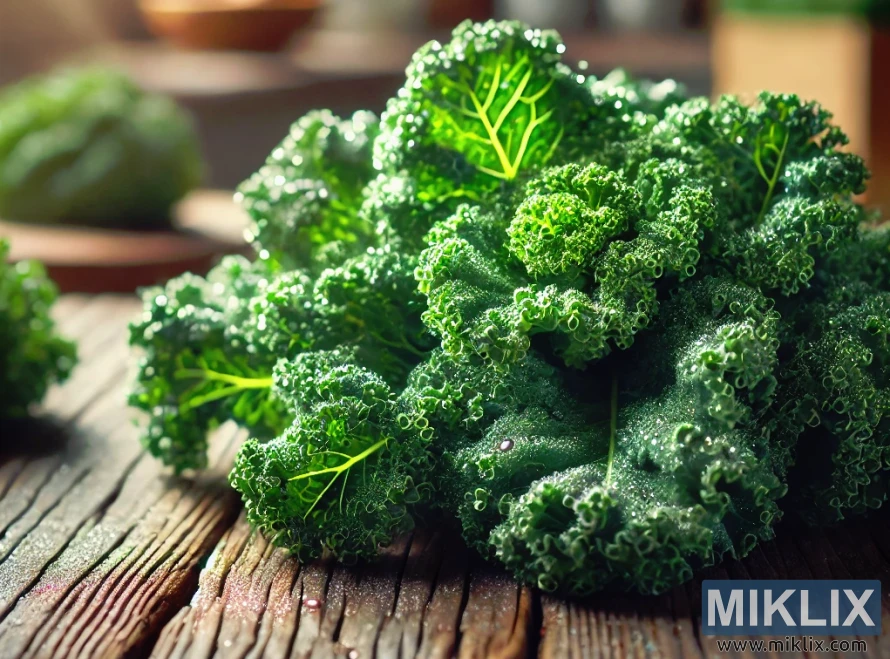Image: Fresh Kale Close-Up
Published: March 26, 2025 at 6:12:33 PM UTC
Last updated: September 20, 2025 at 11:07:59 AM UTC
A close-up of curly kale on a rustic table, highlighted by natural light and water droplets, symbolizing health and freshness.
The image captures a radiant still life of kale, presented in a way that highlights its natural beauty, vitality, and association with nourishment. At the center of the composition lies a lush bundle of curly kale, its deep green leaves spreading outward with a sense of vibrancy and freshness. The surface of the leaves glistens with tiny droplets of moisture, as though they were just harvested from a garden or rinsed under cool water, emphasizing purity and life. The kale’s distinctively ruffled edges, twisting and curling into intricate forms, create a striking texture that catches the warm sunlight filtering in from a nearby window. Light dances across the veins of the leaves, illuminating them with a golden-green glow and drawing attention to their complexity and resilience.
The rustic wooden surface beneath the kale serves as more than just a background—it adds an earthy quality to the scene, grounding the freshness of the greens in a sense of authenticity and natural simplicity. The weathered lines and textures of the wood evoke a farm table or a kitchen steeped in tradition, linking the kale back to its origins in the soil. This contrast between the rough wood and the delicate vibrancy of the kale creates harmony in the image, underscoring the timeless relationship between the earth and the food it provides. Subtly blurred details in the background suggest a kitchen space filled with quiet domestic life, where wholesome meals are prepared and enjoyed. The soft glow from the window further enhances this atmosphere, evoking comfort, warmth, and a mindful approach to food and health.
Kale, long regarded as a symbol of wellness and nutrition, is here portrayed as more than a leafy vegetable—it becomes an emblem of vitality itself. Its reputation as a “superfood” is supported by its wealth of vitamins, including A, C, and K, as well as fiber, calcium, and a remarkable range of antioxidants. In the image, the dew-speckled leaves seem to embody this abundance of nutrients, appearing almost luminous with energy. The freshness conveyed suggests not only physical nourishment but also a mental and emotional sense of renewal, a reminder that eating whole, unprocessed foods brings us closer to nature’s rhythms and cycles of growth.
The visual arrangement conveys a story of health that is at once modern and timeless. On one hand, kale reflects contemporary ideals of clean eating, plant-based nutrition, and sustainability. On the other, the rustic elements in the image suggest a return to older traditions of growing, harvesting, and preparing food with care. This duality makes the image resonate with both present-day lifestyles and ancestral wisdom, bridging the gap between current wellness trends and enduring practices of mindful eating.
Every detail in the frame, from the golden sunlight to the droplets of water and the intricate curls of the leaves, contributes to an atmosphere of freshness, nourishment, and balance. It is an invitation to pause, to reflect, and to appreciate the extraordinary beauty of ordinary ingredients. The kale is not simply presented as food but elevated into a symbol of life’s vitality, reminding us that wellness begins with choices rooted in nature, simplicity, and awareness. Against the quiet backdrop of a kitchen infused with light, it becomes a poetic emblem of the health, energy, and renewal that fresh vegetables bring to our lives.
The image is related to: Green Gold: Why Kale Deserves a Spot on Your Plate

